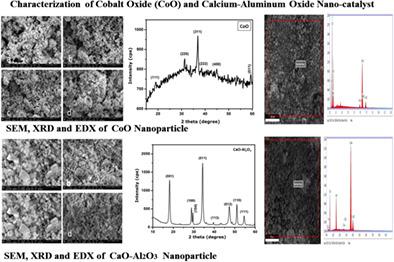当前位置:
X-MOL 学术
›
Microsc. Res. Tech.
›
论文详情
Our official English website, www.x-mol.net, welcomes your
feedback! (Note: you will need to create a separate account there.)
Characterization of Cobalt Oxide and Calcium-Aluminum Oxide nano-catalyst through Scanning Electron Microscopy, X-ray diffraction, and Energy Dispersive X-ray Spectroscopy.
Microscopy Research and Technique ( IF 2.0 ) Pub Date : 2020-05-11 , DOI: 10.1002/jemt.23504 Iram Gul 1 , Shujaul Mulk Khan 1 , Tariq Mehmood 2 , Zeeshan Ahmad 1 , Hussain Badshah 1 , Hussain Shah 3
Microscopy Research and Technique ( IF 2.0 ) Pub Date : 2020-05-11 , DOI: 10.1002/jemt.23504 Iram Gul 1 , Shujaul Mulk Khan 1 , Tariq Mehmood 2 , Zeeshan Ahmad 1 , Hussain Badshah 1 , Hussain Shah 3
Affiliation

|
The Cobalt Oxide and Calcium‐Aluminum Oxide nano‐catalysts were analyzed using Scanning Electronic Microscopy (SEM), X‐ray diffraction (XRD), and dispersive X‐ray spectroscopy (EDX) techniques. Preliminary results showed that the particles of Cobalt Oxide exhibit sponge like morphology and homogenous distribution as per confirmation via SEM. Its average particle size ranges to 30.6 nm demonstrating enormous number of pores and aggregative in nature. Its various peaks were ranging from 19.2 to 65.4 after XRD analysis. The highest intensity was observed at 36.9 position. The energy dispersive spectroscopy techniques were used to calculate the elements present in sample according to their weight and atomic percentage. The cobalt oxide contain cobalt as the most abundant element with 46.85 wt% and 18.01 atomic percent. It contain oxygen with 30.51 wt% and 43.19 atomic percent. Whereas, SEM of calcium aluminum oxide showed random morphology. According to the calculation of Scherrer equation regarding XRD analysis, it was distributed homogenously with particle size ranges from 30 to 40 nm. Its porous morphology was due to the interconnecting gaps between different particles. It result the eight peaks ranging from 18.1 to 62.7 in XRD spectrum. The highest intensity observed at 35.1 with average crystallite particle size of 25.6 nm. The calcium aluminum oxide contain aluminum 7.45 wt% and 6.93 atomic percent. The calcium was the most abundant element with54.7 wt% and 34.24 atomic percent followed by oxygen with 37.26 wt% and 58.42 atomic percent. It was concluded that the SEM, XRD, and EDX are the most significant techniques to characterize nano‐catalysts in particular and other compounds generally.
中文翻译:

通过扫描电子显微镜,X射线衍射和能量色散X射线光谱学表征氧化钴和氧化钙铝纳米催化剂。
使用扫描电子显微镜(SEM),X射线衍射(XRD)和色散X射线光谱(EDX)技术分析了氧化钴和氧化钙铝纳米催化剂。初步结果表明,根据SEM证实,氧化钴颗粒表现出海绵状的形态和均匀的分布。它的平均粒径在30.6 nm范围内,这表明有大量的孔并且本质上是聚集的。XRD分析后,其各种峰的范围为19.2至65.4。在36.9位置观察到最高强度。能量色散光谱技术用于根据样品的重量和原子百分比计算样品中存在的元素。氧化钴含有46.85wt%和18.01原子%的钴作为最丰富的元素。它含有30的氧气。51重量%和43.19原子%。而氧化铝钙的SEM显示出随机的形态。根据关于XRD分析的Scherrer方程的计算,其均匀地分布,粒径范围为30至40nm。其多孔形态是由于不同颗粒之间的互连间隙。在XRD光谱中产生8个峰,范围从18.1至62.7。在35.1处观察到最高强度,平均微晶粒径为25.6 nm。氧化铝钙铝含有7.45重量%和6.93原子%的铝。钙是最丰富的元素,含量为54.7重量%和34.24原子%,其次是氧气,含量为37.26重量%和58.42原子%。结论是SEM,XRD,
更新日期:2020-05-11
中文翻译:

通过扫描电子显微镜,X射线衍射和能量色散X射线光谱学表征氧化钴和氧化钙铝纳米催化剂。
使用扫描电子显微镜(SEM),X射线衍射(XRD)和色散X射线光谱(EDX)技术分析了氧化钴和氧化钙铝纳米催化剂。初步结果表明,根据SEM证实,氧化钴颗粒表现出海绵状的形态和均匀的分布。它的平均粒径在30.6 nm范围内,这表明有大量的孔并且本质上是聚集的。XRD分析后,其各种峰的范围为19.2至65.4。在36.9位置观察到最高强度。能量色散光谱技术用于根据样品的重量和原子百分比计算样品中存在的元素。氧化钴含有46.85wt%和18.01原子%的钴作为最丰富的元素。它含有30的氧气。51重量%和43.19原子%。而氧化铝钙的SEM显示出随机的形态。根据关于XRD分析的Scherrer方程的计算,其均匀地分布,粒径范围为30至40nm。其多孔形态是由于不同颗粒之间的互连间隙。在XRD光谱中产生8个峰,范围从18.1至62.7。在35.1处观察到最高强度,平均微晶粒径为25.6 nm。氧化铝钙铝含有7.45重量%和6.93原子%的铝。钙是最丰富的元素,含量为54.7重量%和34.24原子%,其次是氧气,含量为37.26重量%和58.42原子%。结论是SEM,XRD,











































 京公网安备 11010802027423号
京公网安备 11010802027423号